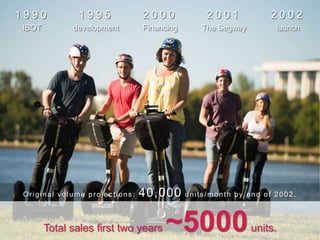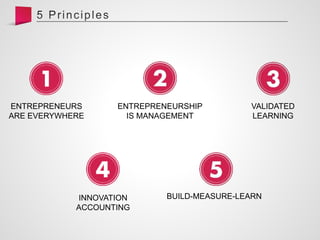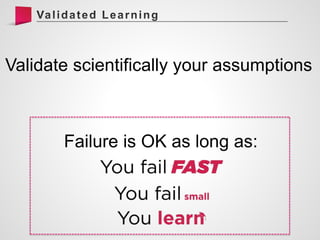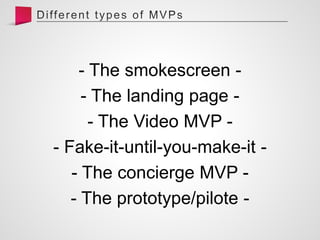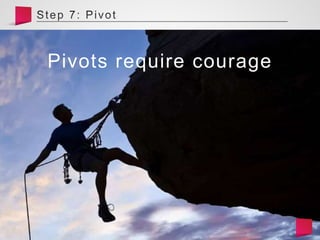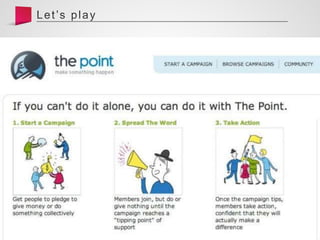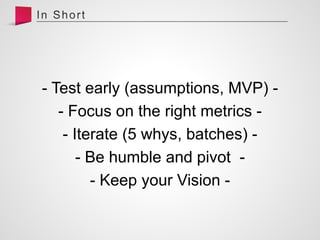Lean Startup @ Université TOTAL 2016
- 3. WHAT? Management method Problem solving Uncertainty WHY? Fast innovation pace Not about startups Avoid failure
- 4. 1. Jump in 2. Explore 3. Understand 4. Think
- 6. 1 9 9 0 IBOT 1 9 9 5 development 2 0 0 0 Financing 2 0 0 1 The Segway 2 0 0 2 launch Original volume projections: 40,000 units/month by end of 2002 . Total sales first two years ~5000units.
- 7. I told you this story because this is NOT lean.
- 9. A strategy, a new product, a project, rely on assumption Planning and forecasting are only accurate when based on a long, stable operating history and a relatively static environment
- 11. - Startups - - Project management - - Governments and politics - - Innovation -
- 13. Failure is OK as long as: Validate scientifically your assumptions
- 15. The loop of Test & Learn is at the core of the scientific method
- 16. The Fairy Tale Realityvs
- 17. - What do you want to learn? - - What are the most risky assumptions? – Feasibility ? Value proposition ?
- 18. Your end product will very likely be different from your starting product Don’t get to attached to the product… what counts is the vision
- 19. ‘‘ If you are not embarrassed by the first version of your product, you launched too late ’’ Reid Hoffman – Founder of Linkedin
- 22. KEY CONCEPT : MVP Minimum Viable Product
- 24. - The smokescreen - - The landing page - - The Video MVP - - Fake-it-until-you-make-it - - The concierge MVP - - The prototype/pilote -
- 26. Cohorts & Actionable Data ACQUISITION ACTIVATION RETENTION REVENUE REFERRAL How do users find you? Do users have a great first experience? Do users come back? How do you make money? Do users tell orthers?
- 27. 5 WHYs - For managing adaption - - Start with a non important issue - - Adapt solution to importance of the issue -
- 28. The RUNWAY If we can reduce the time between pivots we can increase our odds of success before we run out of money (or before the project loose support internally) - is important - - Batches -
- 33. - Zoom-in Pivot - - Zoom-out Pivot - - Customer Segment Pivot - - Customer Need Pivot - - Busines model Pivot - - Channel Pivot - - Technology Pivot -
- 34. - Test early (assumptions, MVP) - - Focus on the right metrics - - Iterate (5 whys, batches) - - Be humble and pivot - - Keep your Vision -
- 35. This change can only come from Senior Management Establish a Sandbox for innovation Cultivate the entrepreneurial portfolio
- 36. Questions ?
Editor's Notes
- Let’s kick off this session, and let me tell you a few words about the Lean Startup and about me !
- Lean Startup: A Management method in environment of extreme uncertainty; It’s a problem solving methodology based on experimentation, learning and experimentation (the Test & Learn) The goal today is not about learning how to build a Lean Startup, but to develop the Lean Thinking, which is the most valuable element. Lean Startup has been created in 2011 Why learn about Lean Startup? Innovations and disruptions are faster that ever before, the uncertainty is very high. We need tools to navigate this uncertainty, as business people, manager and leaders. Because it’s not about startups. It’s about problem solving, it’s about management. It’s applicable to all types of companyes, sectors, indutstries and projects. What makes the common ground, is the existence of high uncertainty. That’s why it make sense to use this kind of methodology to reflect and develop solutions to your projects. You have very wide questions, with a lot of prospective, assumptions and uncertainty.
- In situation of uncertainty, other management tools are needed - Comparaison cycle en V Assumption must be validated (scientifically) People don’t knwo what they want, and we don’t know what they want, unless we experiment It doesn’t matter to do on time and on budget Cycle en V Fallacy
- Let me tell you a story, and here are the 4 heros Who are these guys ? Dean Kamen (the insulin pump AutoSyringe, all-terrain electric wheelchair iBOT, Dean Kamen, a prolific inventor, more than 80 US patents and has created many products. “When Kamen travels to work, he has to decide which of his two helicopters to take. For longer trips, he pilots his own private jet. He also owns a small island near Connecticut that generates its own electricity from wind.” Steve Jobs, Jeff Bezos, John Doerr (2,2 milliards de dollars, Kleiner Perkins Caufield & Byers, Netscape, Compaq, Google, Amazon…)
- Segway HT: New Wheels for the New Millennium As the IBOT's code name had been "Fred Upstairs" after Fred Astaire, the HT was initially known as "Ginger" in honor of Ginger Rogers For the HT, DEKA borrowed from the balancing technology developed for the IBOT. The HT was a two-wheeled platform with handlebars on which the user was seated upright. It used microprocessors and solid-state gyroscopes to balance itself on two wheels. Kamen did not like the word "scooter" applied to the unique invention; in function, he said, the device was more akin to "magic sneakers." Its speed was electronically limited 12.5 mph, though a police version had a theoretical top speed of more than twice that. Conventional friction brakes would not work, since it needed to keep its wheels active to balance itself; in the HT's braking process, energy from stopping was transferred back into the batteries. The HT would cost $100 million to develop. Backing its commercial launches were Credit Suisse First Boston and the Silicon Valley venture capital firm Kleiner Perkins Caufield & Byers, which had previously bet on Netscape and Amazon.com. Kleiner Perkins partner John Doerr predicated Segway LLC would reach $1 billion in sales faster than any other company, reported Vanity Fair. The firm was valued at a colossal $600 million; Kamen gave up less than 15 percent of the company to his financiers: Credit Suisse and Kleiner Perkins invested $38 million each for their respective 7 percent shareholdings. These investments were lined up in the spring of 2000.
- Spent millions in product and lobbying Without validating the Value Hypothesis, Didn’t know what the customer wanted
- The SoloWheel 10kg, diameter of 45cm, 25cm wide
- In situation of uncertainty, other management tools are needed - Comparaison cycle en V Assumption must be validated (scientifically) People don’t knwo what they want, and we don’t know what they want, unless we experiment It doesn’t matter to do on time and on budget Cycle en V Fallacy
- The fundamental activity of a startup is to turn ideas into products, measure how customers respond, and then learn whether to pivot or persevere. All successful startup processes should be geared to accelerate that feedback loop.
- You don't have to work in a garage to be in an entrepreneur. Not only for startups As soon as there is a business plan, project management, uncertainty Every business plan has assumptions! But how to validated these assumptions?
- A startup is an institution, not just a product, so it requires management, a new kind of management specifically geared to its context of high uncertainty. During many years, you had 2 “approaches” of entrepreneurship and project management. The business plan unacurate (even today are not asked by early stage VCs). The Just do it, and see what happens little learning from the market
- We are in a world of data: but some are not actionable, and sometimes misleading. Example: Number of subscribers… not good. To improve entrepreneurial outcomes, and to hold entrepreneurs accountable, we need to focus on the boring stuff: how to measure progress, how to setup milestones, how to prioritize work. This requires a new kind of accounting, specific to startups.
- We are in a world of data: but some are not actionable, and sometimes misleading. Example: Number of subscribers… not good. To improve entrepreneurial outcomes, and to hold entrepreneurs accountable, we need to focus on the boring stuff: how to measure progress, how to setup milestones, how to prioritize work. This requires a new kind of accounting, specific to startups.
- This Build-Measure-Learn feedback loop is at the core of the Lean Startup model. Our education or character emphasize one element, but the 3 are important. The fundamental activity of a startup is to turn ideas into products, measure how customers respond, and then learn whether to pivot or persevere. All successful startup processes should be geared to accelerate that feedback loop. To build a right Build-Measure-Learn loop, you must work backwards: First figure out what we need to learn, then work on a product that will work as an experiment to get that learning. To apply the scientific method, we need to identify the hypotheses to test, (and usually the riskiet in the business plan ). Once this hypotheses are indentify, the first step is to enter the Build phase as quickly as possible, with an MVP. Tje MVP is the version of the product that enables a full experience (B-M-L loop) with a minimum amount of effort. When we enter the Measure phase, the challenge is to determine is the progress is significant. Are we closer to what customer wants? Because, if we’re building someting that nobody wants, it doesn’t matter if we are doing in on time an on budget. Learning through in-depth analysis and the 5 whys. And finally, most important, there is the pivot. After iterating the Build-Measure-Learn Loop, we have to decide wether to pivot or persevere.
- Strategy is based on assumtions
- Definition 2 risks: Spending so much time on the preparation, that action never happens Spending a lot of money and time to build something that noone wants to buy Early action, going to the market, learn and adapt But not doing that in a way: « try and see what happens » It’s a more scientific approach base one assumptions Value Assumptions, Growth Assumptions, Other assumptions
- Virgin Air started with just one plane flying between two locations. It delivered on it’s most core value proposition. After testing the concept and improving the offering they expanded their fleet. Angellist is a marketplace that connects startups and investors. The problem they're solving is that it's hard for both sides of the marketplace to find each other. The way they solved this core problem initially, their MVP, was by making email introductions. They made email intros connecting a startup they knew looking for funding and investor they knew looking for investments. It delivered on the core value proposition that Angellist still offers today. Zappos is an ecommerce site where people can buy shoes online. To test that value proposition, they took pictures of shoes at local stores, posted the pictures online, put them up for sale on their site, and when customers purchased the shoes, the company would by them from the stores at full price and ship them to their customers.
- Small Batches and sandbox = make cheap mistakes quickly and start learning
- Toyota
- Trap of the « vanity metrics », unclear hypothesis, Ego and accepting we were wrong, focused on the product not vision Pivot early gives better chances of survival and success PIVOT = find an alternative way to achieve the vision That’s why it’s important to start with a vision and not with a product. A product leave little room to adjustements. It is a one time trial. A vision gives you room to pivot.
- What do successful startups have in common? They pivoted. - They started out as digital cash for PDAs, but evolved into online payments for eBay. - They started building BASIC interpreters, but evolved into the world's largest operating systems monopoly. (Microsoft avait mis au point l'interprète BASIC pour l'Altair 8800, un micro-ordinateur du début des années 70.) - They were shocked to discover their online games company was actually a photo-sharing site.
- Platform: open it to other players
- Focus on the vision, not the product !
- A Sandbox is a low-risk, controlled environment, strictly limited (a part of a product or a service, only a certain customer segment or just a territory). 7 rules of a sandbox: 1- any team can create an A/B experiment in the sandbox, 2 – One team must be accountable for each test from end to end, 3- Experiments are limited in time, 4- Experiments are limited to a number of customers (usually a percentage of the full base), 5- The metrics are simple, actionable and similar for all the experiments, 6- the experiment is closely monitored, never launched on week-ends, with a abortion plan if something catastrophic happens.





